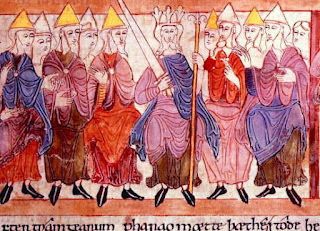Readers of this blog are probably familiar with the pope's work to "fix" the calendar when he realized that the Julian calendar was "off" by several days. Sure, the Julian took into account that a "year" is actually 365 and a quarter days, but it wasn't exactly a quarter-day off, and so adding a day every four years wasn't sufficient to even things out. Every 131 years, the solstices and equinoxes would be off by a day. This was a real problem for the Church, because over the centuries Easter started shifting to summer, rather than spring.
Pope Paul III (1468-1549) saw the problem and gathered several astronomers to develop reforms.* Then Paul III died, five popes came and went, and in 1572 Pope Gregory XIII was elected and found himself faced with a growing problem and several possible solutions. He mulled it over for a few years, and then declared to the world:
- The Leap Day would move to after February 28 (it had been tucked in before February 25).
- The date of Easter would be calculated differently.
- A Leap Year that is divisible by 400 will not have a Leap Day.
- Ten days needed to be omitted from the calendar, to bring it back into alignment with the solstices. Accordingly, in 1582, the day after Thursday, October the 4th, was Friday the 15th.
The 1582 change gave rise to a slight oddity for historians, because technically, every date prior to October 4th, 1582 is a Julian date, but also has a corresponding Gregorian date that is several days different. How you count it depends on whether you consider the date to be just a label given by those who were there at the time, or a certain number of days prior to the present day. Or its important if you want to declare the anniversary of an event.
Anyway, enjoy your extra second; it will be added just before midnight, so feel free to stay up so you can say you remember the time when a minute was 61 seconds long!
*Copernicus had dedicated his work De revolutionibus orbium coelestium (On the Revolutions of the Celestial Spheres) to Pope Paul III, hoping it would save him from potential hostility for his radical thoughts. Had Paul called, Copernicus probably would have come running to join the team of calendar reformers; alas, he had died in 1542.





